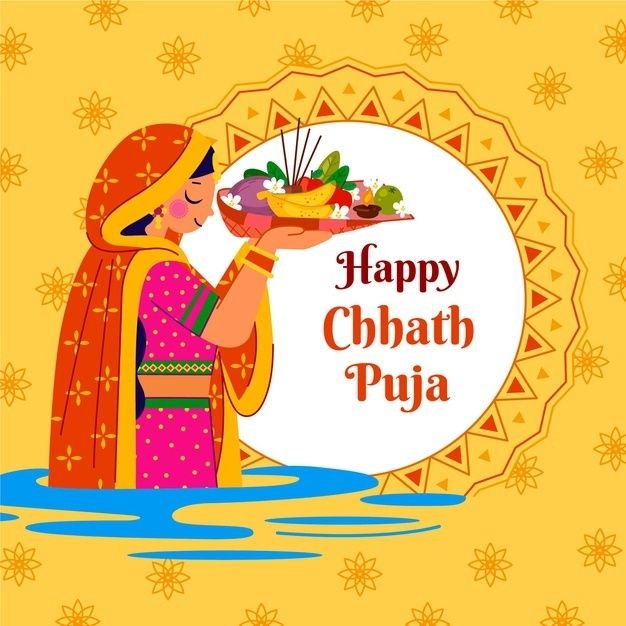Hindu festival Chhath
Chhath
Chhath Puja is a prominent Hindu festival dedicated to Surya (the Sun God) and Chhathi Maiya (Mother Goddess Usha), celebrated mainly in Bihar, Jharkhand, Uttar Pradesh, and Nepal. Observed over four days, the festival involves rituals of fasting, holy bathing, and offering prayers to the rising and setting sun. It is considered one of the most devotional and rigorous festivals, emphasizing purity, gratitude, and reverence for nature and life-sustaining forces.


Chhath Puja is a major Hindu festival dedicated to Lord Surya (the Sun God) and Chhathi Maiya (Mother Goddess Usha), celebrated primarily in Bihar, Jharkhand, Uttar Pradesh, and Nepal. Observed over four days, it involves fasting, holy bathing, and offering prayers to the rising and setting sun.






Rituals & Traditions of Chhath

Chhath Puja is celebrated with strict devotion and unique rituals over four days, emphasizing purity, gratitude, and reverence to Lord Surya (Sun God) and Chhathi Maiya. The main rituals include:
- Nahay Khay (Day 1): Devotees take a holy bath in rivers, ponds, or clean water sources and prepare vegetarian meals in absolute cleanliness, marking the beginning of the festival.
- Lohanda/Kharna (Day 2): Devotees observe a day-long fast without water, breaking it in the evening with prasad like kheer, fruits, and thekua (wheat flour cookies).
- Sandhya Arghya (Day 3): Devotees gather at riverbanks or ponds at sunset, standing in water, and offer Arghya (water offerings) to the setting sun along with fruits, sugarcane, and flowers.
- Usha Arghya (Day 4): On the final day, devotees offer prayers to the rising sun at sunrise, concluding the fast and rituals. Special prayers, songs, and hymns are sung to seek blessings for health, prosperity, and family welfare.
Throughout the festival, participants observe strict purity rules, avoiding meat, alcohol, and sometimes even water during certain rituals. Community participation is significant, as families and neighbors gather on riverbanks, making Chhath Puja a collective celebration of devotion, discipline, and gratitude.
Spiritual Importance & Cultural Significance
Chhath Puja holds profound spiritual and cultural significance in Hindu tradition. Spiritually, it is a festival of gratitude, devotion, and purification, where devotees offer prayers to Lord Surya (the Sun God) and Chhathi Maiya for health, longevity, and prosperity. The rituals of fasting, holy bathing, and offering Arghya to the rising and setting sun symbolize discipline, self-control, and inner purification, reflecting the devotee’s surrender and reverence to divine forces. Chhath Puja encourages mindfulness, humility, and a deep connection with nature as a life-sustaining force, emphasizing respect for the sun, water, and earth.
Culturally, the festival strengthens family bonds and community unity, as families and neighbors gather on riverbanks or ponds to perform rituals together. Traditional preparations, including vegetarian prasad like thekua, fruits, and kheer, along with decorating the surroundings with lamps and rangoli, enhance the festive atmosphere. Chhath Puja also preserves regional customs, folk songs, and cultural heritage, making it a celebration of both spiritual devotion and communal harmony. Overall, the festival embodies the values of purity, gratitude, devotion, and respect for nature, fostering both personal and social well-being.


Food & Sweets & Modern Celebrations

Chhath Puja holds profound spiritual and cultural significance in Hindu tradition. Spiritually, it is a festival of gratitude, devotion, and purification, where devotees offer prayers to Lord Surya (the Sun God) and Chhathi Maiya for health, longevity, and prosperity. The rituals of fasting, holy bathing, and offering Arghya to the rising and setting sun symbolize discipline, self-control, and inner purification, reflecting the devotee’s surrender and reverence to divine forces. Chhath Puja encourages mindfulness, humility, and a deep connection with nature as a life-sustaining force, emphasizing respect for the sun, water, and earth.
Culturally, the festival strengthens family bonds and community unity, as families and neighbors gather on riverbanks or ponds to perform rituals together. Traditional preparations, including vegetarian prasad like thekua, fruits, and kheer, along with decorating the surroundings with lamps and rangoli, enhance the festive atmosphere. Chhath Puja also preserves regional customs, folk songs, and cultural heritage, making it a celebration of both spiritual devotion and communal harmony. Overall, the festival embodies the values of purity, gratitude, devotion, and respect for nature, fostering both personal and social well-being.




















































